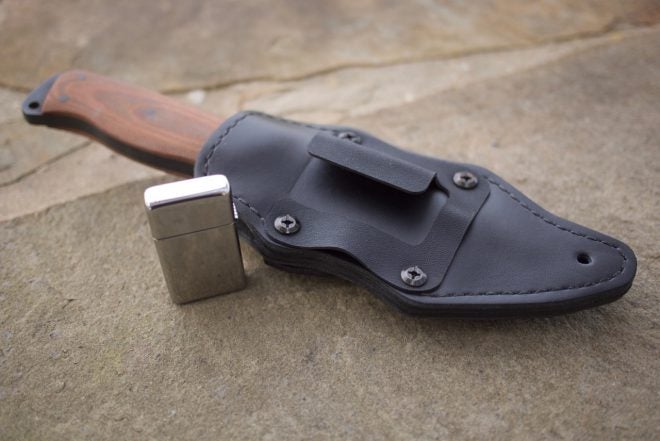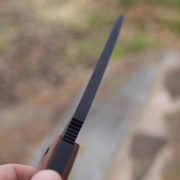First Impressions: Case/Winkler Recurve Utility Knife
Jon Stokes 03.19.18

I’m a sucker for big, beefy camp knives, so when I handled the new Case Winkler Recurve Utility at the Case booth and at the Winkler booth, it was love at first sight. I knew I had to get my hands on this knife one way or the other, so I contrived to get one from Winkler when I got back from the show.
Like the Skinner, the Recurve Utility is part of the American Heroes series of collaborations between Case Knives and Daniel Winkler Knives. The Recurve Utility was designed by Winkler and retired Navy SEAL Harold Bologna.
“It was incredibly humbling to be selected as the next collaborator in the American Heroes Knife Series, working alongside Case and Winkler Knives to create a product that not only takes inspiration from my time serving in the military, but from my childhood experiences fishing, crabbing, and hunting in Louisiana,” says Bologna in the knife’s press release.
“These two companies have demonstrated an ongoing commitment to U.S. manufacturing and our nation’s military, and with Case’s nearly 130 years of experience in the industry, I could not have asked for better partners to help bring our shared vision to life.”
The basic specs are as follows:
Blade length: 4 3/4 in
Overall length: 9 1/2 in
Weight: 12.25oz
Steel: 80CrV2
The knife
I can’t do the whole unboxing photos thing with this knife, since the packaging wasn’t finalized when I got my hands on this. Also, there’s an engraved Zippo lighter that comes with the blade, and that wasn’t available, either. So while I can talk about the knife and sheath, I don’t quite have the full package available, yet.
As you can see from the pictures, the Recurve Utility takes its name from its 4 3/4-inch blade, which has a wide belly and a slight recurve to it. A recurve on a blade like this makes it a bit better of a slicer, since there’s more angled edge area for you to use when drawing the blade across something.
The balance on this blade also shifts a bit more toward the tip than it would without the recurve, so it’s slightly better for chopping. Although, I’m not much on chopping with knives — I either pack a hatchet or a saw for serious wood processing.
As for the overall blade itself, it’s a full (skeletonized) tang fixed blade that’s cut from a piece of 1/4″ 80crV2 steel. This is a really tough, high-carbon steel, and a lot of custom makers are using it, now. You get most of the toughness of something like CPM 3V, but with much easier sharpening.
You can see from the pictures how thick the blade stock is. With a steel this tough, the blade could’ve been thinner (like the Skinner) and it would still be nigh indestructible. However, I really like how hefty and substantial this thicker design feels in the hand. Sometimes, overkill just feels right, and this is one of those times. With this thick of a piece of properly heat treated 80crv2, you are never, ever, under any circumstances going to bend or break this blade. Using the Recurve Utility as a prybar could damage the edge, but even with a substantial amount of weight behind it you’re not going to bust this thing.
The downside to the thickness, of course, is that it can make some types of game processing tasks a little less efficient. I can’t imaging trying to fillet a bass with this thing, for instance.
As with the Skinner, the jimping on the spine helps with grip and isn’t overdone. There’s also a bit of a thumb ramp, which, when combined with the recurve on the edge, gives the overall blade a bit of an “S” shape.
There are two lanyard holes, one at the top of the tang and one at the bottom. Quite a few people like to tie their lanyard at the top hole of a knife, so this gives you that option.
The G10 handle slabs are flawlessly mated to the tang, and the pins are ground down smoothly onto the top of it.
The blade finish is black Caswell, an oxidized finish that Winkler is using on most of its 80crV2 products, now. It looks attractive, and I can testify that it does patina nicely with wear.
The sheath
Like with all of Winkler’s offerings, the sheath is a wonder. In fact, this knife sheath is far and away the nicest sheath I’ve ever seen on a production blade. It’s a Kydex/leather hybrid, where each half of the sheath is a piece of Kydex sandwiched between two pieces of leather. This ensures that the sheath will keep its shape, and makes it exceptionally tough.
Attached to the back of the sheath via five screws is a belt clip, which can be removed and moved to the other side for alternate side carry.
Finally, on the front of the sheath is a Zippo lighter holder, which holds a Zippo slim. We’ve talked before on here about the many benefits of the Zippo as a survival tool, but for whatever reason it had never occurred to me to mount one of these on a knife sheath before.
Since my version of the knife didn’t come with the engraved lighter that will be included with the retail version, I ordered and armored Zippo Slim from Amazon.
Retention of this lighter in the attached slot is just okay, but I didn’t really trust it to stay in if I knocked the blade around. So, I did what I often do — I busted out the GT-500 grip tape and applied it to the lighter. The lighter now stays in extra snugly, but it’s still easy enough to remove if you need it.
The one downside of the Zippo as the lighter choice, here, is that it just doesn’t take very long for the fuel to evaporate from these things. I greatly prefer the Maratec Peanut Lighter XL in Titanium to the Zippo, because the Peanut has an o-ring and will retain fuel indefinitely. The Peanut also takes Zippo fuel and Zippo replacement parts (wicks, flints, wheels). So despite the fact that it’s spendy, it’s better than the Zippo as a survival lighter in every respect.
(I’m actually thinking of getting some Kydex and trying to make a version of that front lighter holder that can hold the Peanut instead of the Zippo. I’m not entirely sure it’s worth it, though, vs just having an extra fire pouch on my belt with the Peanut and some kindling in it.)
Conclusions
Overall, every part of the Recurve Utility, from the sheath to the knife itself, radiates the impression of being ridiculously overbuilt. It’s the armored personell carrier of camp knives, and it feels absolutely indestructible.
It’s a serious blade for serious use, and the custom level of fit and finish comes with a custom level price tag: $395 MSRP. That is a lot of money to drop on a production fixed blade, but I imagine the sheath is a big part of the cost, there.
Like the Skinner, this is an excellent “one knife” candidate. Picking between the two comes down to the range of expected uses, and the price tag (the Skinner is $100 cheaper). The Skinner is better as a game processing and self-defense weapon, but is not what you want for prying, digging, heavy wood processing, demolition/search-and-rescue, or other borderline-abuse applications. The Recurve Utility is not ideal for game processing or stabbing (though it could do both), but is a much better fit for extreme applications that would damage a thinner blade.
In the end, this is one of those knives that it’s just impossible to go wrong with. If the design speaks to you and you can afford it, just go for it. You won’t be disappointed.
































